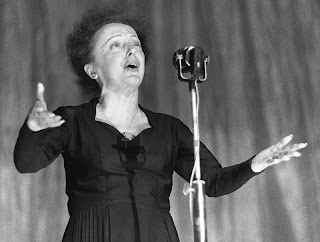The Hackney Empire hosted royalty – Romany royalty - last night. The beautifully ornate Victorian theatre, so shabbily splendid that you could imagine Angela Carter’s Fevvers flying above the heads of the assembled revellers, was the perfect setting for an incredible line-up of two of the brightest jewels in Roma music’s spangled crown: Taraf de Haidouks, supported by Boban I Marko Markovic Orkestar.
Boban wasn’t able to perform for personal reasons, but Marko, the stellar Serbian trumpeter’s son, proved himself worthy of the title of anointed heir, leading the Orkestar through a set of jazzy, oriental coceks that proved that a band of portly, hoodlum-looking young men with tubas and trumpets can teach the world a thing or two about rocking out, and rocking hard. Oozing testosterone, swagger, swank and gypsy flash, they parped out snakey, insistent sounds that induced a collective sweat-soaked delirium. This was music so upbeat and infectious that not moving to it wasn’t an option: it was heady, glorious stuff.
Marko and his band of tuba-toting troubadours took no prisoners in forcing the audience to live in the moment, but the fabled Taraf de Haidouks transported them to an older, stranger place. Apparently timeless, the virtuoso Romanian band of lautari play music so deep and wild that as you hear it and are drawn into their world, you somehow understand that you are hearing stories – strange, terrible and beautiful - that are elemental, or universal, and completely entrancing.
Taraf have survived the deaths of two of their members, the legendary violinist Nicolae Neacsu and singer and cimbalon player Cacurica, and their shifting line-up makes it feel as if the music they are channelling is of more significance than any one member of the band, no matter how vast his contribution may have been. Onstage, it looks shambolic as veteran Taraf members come and go, but with each tune they cast a spell that is powerfully potent. In particular, singer Ilie Iorga raises hairs on the backs of necks with the Cind Eram La, a chronicle of a peasant uprising; to call it haunting is an understatement. Razor-thin flautist Falcaru blows thrilling, trilling notes from his instrument like a demented Pied Piper; his solo in Flight Of The Bumblebee is so fast and so fluid that it seems impossible for a human being to produce such shimmering, quicksilver sound. An hour and a half passes as if in a dream, and having been transported by the Taraf into what felt like another world, afterwards it seemed as if they were only onstage for a few brief, magical minutes.
Thursday 22 July 2010
Friday 9 July 2010
The man who shares a house with Edith Piaf

Yesterday I met a man who knew Edith Piaf. Bernard Marchois, who runs the Edith Piaf museum tucked down a sidestreet in Menilmontant, first saw her perform when he was 16. Today, nearly 40 years after her death, his life is utterly entwined with that of the dead singer. The former teddy boy is a tall, elderly, elegant gentleman with a deep tan and a very slight stoop, courteous and world-weary, who welcomes Piaf’s disciples to the two rooms in Menilmontant that comprise the extraordinary Edith Piaf Museum: a place so intimate that it feels as if it’s her home.
In fact, it’s his home, although he told me that once, for a short while, in 1933, it was also hers. Four flights up, the two rooms packed with Piaf’s worldly goods are part of his flat. You have to make a private appointment to visit; Marchois speaks personally to each would-be worshipper at the Piaf shrine; allocates them a time and gives them the door codes necessary to gain entrance to the building.
Inside, every inch of the two small rooms is pervaded by Piaf’s forcible presence. A life-sized lack-and-white cut-out of her rather spookily dominates the room despite her tiny size; I’m 5’5” and the top of her head was level with my bra. But, as a recorded version of La Vie En Rose drifts shamelessly through the air, it is obvious why the Little Sparrow has such a hold on French hearts, and those of other romantics, wherever they might be born.
The rooms are full of paintings, photographs and hand-written tributes, but the most fascinating items are the things she might have worn, touched, or loved. Her tiny shoes are there, as are two of the black dresses she famously wore when she performed – both enveloped in plastic, and once tucked behind a door - and the accompanying crucifixes. There’s the limited edition perfume La Mome; her great love Marcel Cerdan’s boxing gloves; an enormous plush bear given to her by last husband Theo, and incongruously, a housecoat in rich, warm red velvet. But then, Marchois says that, in person, she was different from how this icon of heartbreak and defiant survival appeared when she sang: in life, he says, she was funny, and loved to laugh.
She certainly knew how to inspire love. Marchois has written two books about her and devoted his life to tending her flame and welcoming her devotees to his apartment. You can almost feel Piaf in the room, and if you were to believe in ghosts, you might feel hers was hovering, just about to make an entrance.
Subscribe to:
Posts (Atom)
